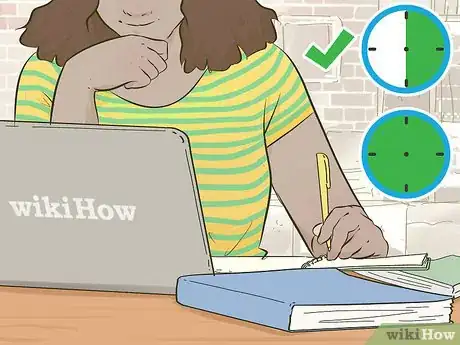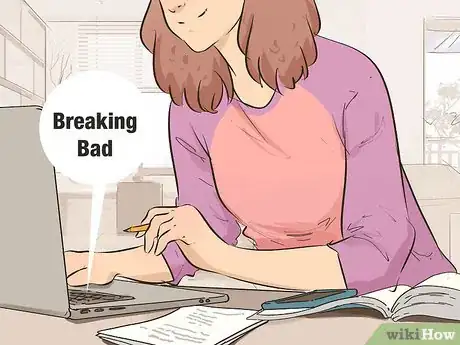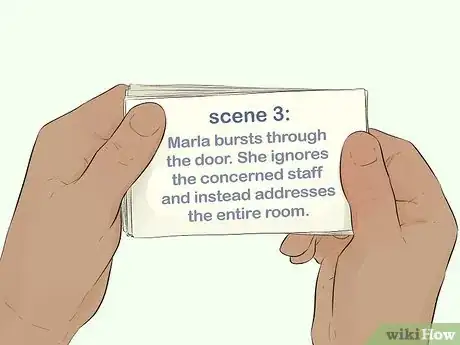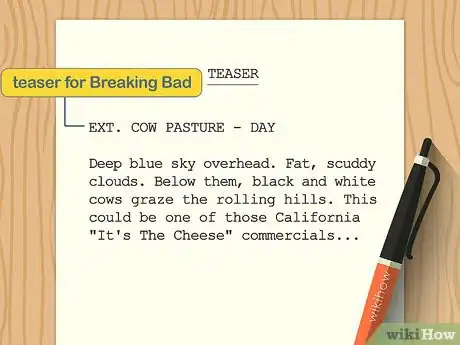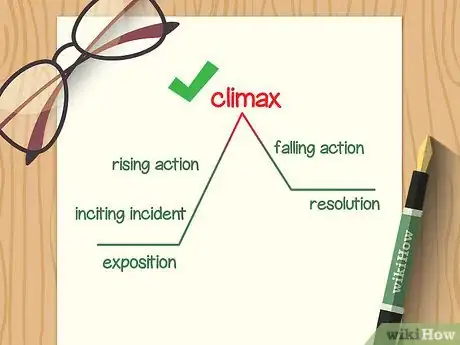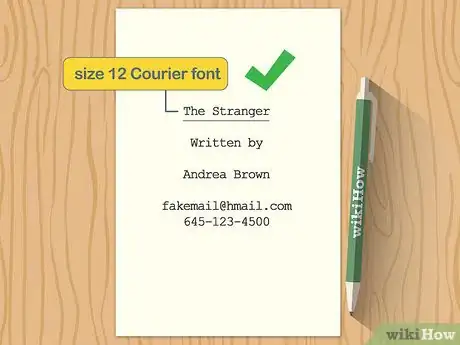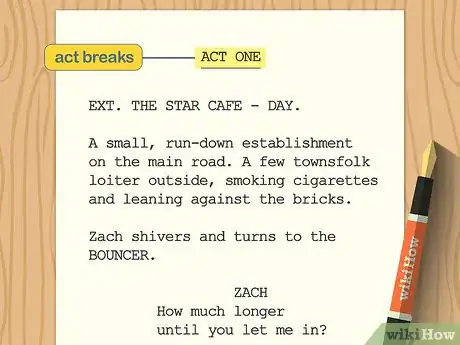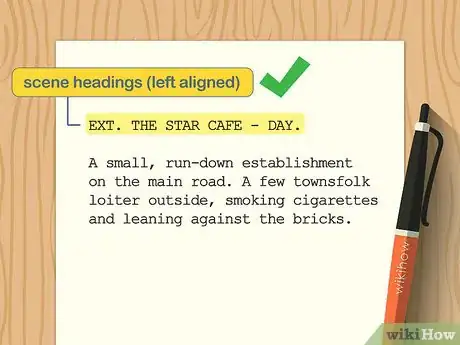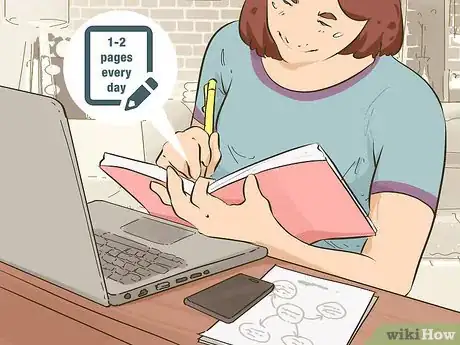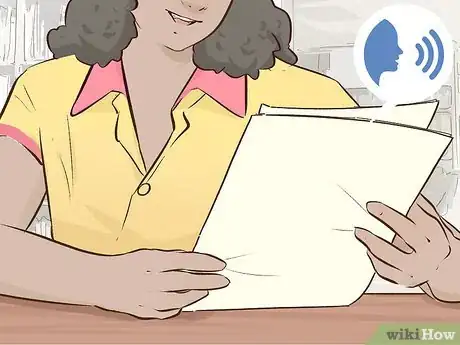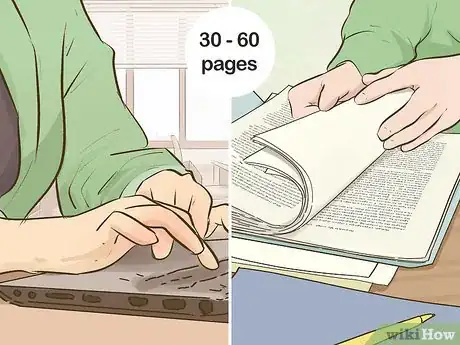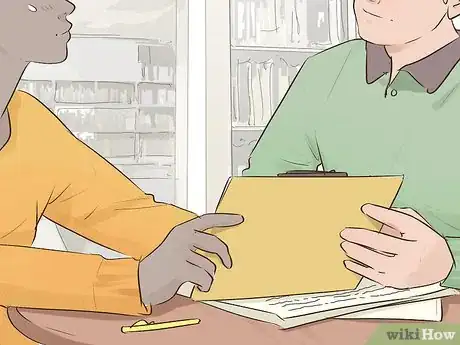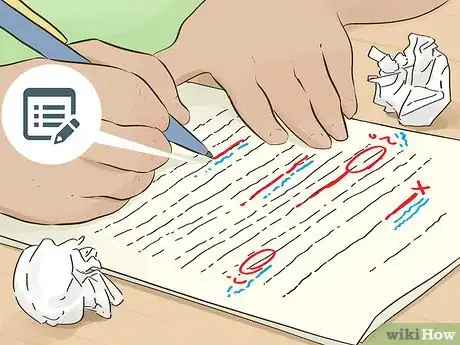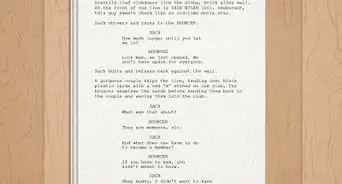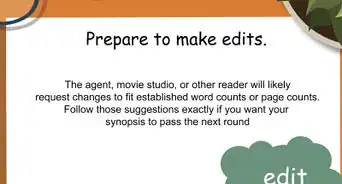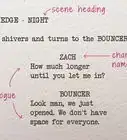This article was co-authored by Lucy V. Hay and by wikiHow staff writer, Hunter Rising. Lucy V. Hay is an author, script editor and blogger who helps other writers through writing workshops, courses, and her blog Bang2Write. Lucy is the producer of two British thrillers and her debut crime novel, The Other Twin, is currently being adapted for the screen by Free@Last TV, makers of the Emmy-nominated Agatha Raisin.
There are 9 references cited in this article, which can be found at the bottom of the page.
wikiHow marks an article as reader-approved once it receives enough positive feedback. This article received 21 testimonials and 90% of readers who voted found it helpful, earning it our reader-approved status.
This article has been viewed 505,715 times.
Every year, TV networks and streaming services release multiple new shows that all started off as scripts. If you want to write for TV, create a script of your own to showcase your talents. After you brainstorm ideas and make an outline, write the first draft of your script so it's correctly formatted. With a little bit of hard work and creativity, you can have a TV script written within a couple of months!
Steps
Choosing a Format
-
1Choose between a 30-minute or 1-hour show. Television scripts fall into 2 categories: 30-minute comedies or 1-hour dramas. When you want to write a script, consider what type of show you like to watch and want to write. If you want to make something more serious, aim for an hour-long show, but if you want to try writing something funny like a sitcom, pick a 30-minute show.[1]
- Scripts for 30-minute comedies are shorter than those for hour-long dramas, but jokes may be more difficult to write.
-
2Write an episode of an existing show if you don't want to create characters. Spec scripts are episodes you write of a TV show that's already on the air. Pick a show that you're familiar with and brainstorm stories using the characters from it. Choose a storyline that hasn't happened in the previous episodes and work out how the characters will handle the situation.[2]
- Look online for examples of scripts for the TV show you want to write.
- Watch multiple episodes of the show you want to write a spec script for so you familiarize yourself with how characters interact.
Tip: If you're looking for a job as a TV writer, avoid writing spec scripts for shows that are finished or canceled. For example, you shouldn't write scripts for shows like Friends or The Office, but you could write an episode of Rick and Morty or Riverdale.
Advertisement -
3Make an original pilot episode if you want to create something new. If you want to create your characters, setting, and story from scratch, you can create an original pilot, which is the first episode of a series. Brainstorm characters your story follows, the setting, and the genre you want for your script. Use “What If?” questions to form the ideas for your script and free-write any ideas that come to your head.[3]
- For example, “What if a documentary crew followed the crazy day-to-day events in an office?” is the premise for The Office, while “What if a chemistry teacher uses his knowledge to create and sell illegal drugs?” is the premise for Breaking Bad.
- The pilot script introduces readers and viewers to your characters and story that the rest of the season will tell.
- You do not have to write all the episodes of your TV show.
-
4Create a 1-2 sentence logline to summarize the episode you're writing. Once you have an idea for your story, try to summarize the plotline in 1-2 sentences. Use descriptive language to help your logline sound unique and pique the interest of someone reading it. Include the main conflict of the episode in your logline so readers know what to expect from your script.[4]
- For example, a logline for the first episode of Breaking Bad is, “A chemistry teacher learns he has cancer, so he decides to make and sell illegal drugs to raise money for his surgery.”
- If you're creating an original pilot, you might want to write a logline for your entire series so someone has an idea of what to expect if there are ever more episodes made.
Outlining the Story
-
1Write scenes you want to include on note cards. Put individual scene ideas on separate note cards so you shuffle and rearrange them if you want to. Make sure the writing is clear and legible so you can read it later. Include every idea you come up with even if you think they're bad since you may not know what will work in the final script.[5]
- If you don't want to use note cards, you can also type the events in a word document or screenwriting software, such as WriterDuet or Fade In.
- Some screenwriting software has built-in note card functions so you can rearrange and edit things easily.
-
2Arrange the scenes in the order you want them to appear in your script. Organize your note cards on a table and lay them out in the order you want them to happen. Make sure one event leading into the next makes sense or else your script may be confusing. If some of your note cards don't work in your outline, set them aside or edit them so they fit with the rest of your storyline.[6]
- Play around with the continuity and order of the events if you want to make TV shows that are mind-bending or have twists, such as Westworld.
-
3Hook readers with a teaser or cold open. The cold open, also known as the teaser, is a 2-3 page scene that starts the episode. In a pilot script, the teaser starts by introducing the characters and hinting at the conflict in the rest of the episode. Set your teaser in 1 location so it's simple and easy to follow. The rest of the teaser depends on the type of show you're writing.[7]
- Comedies usually have a funny cold open that ends on a joke, much like the scenes in Parks and Recreation before the opening credits.
- Dramas tend to have a teaser that ends in a cliffhanger that leads directly into the conflict for the episode. For example, teasers in shows like Criminal Minds usually introduce the killer or the crimes that need to be solved.
-
4Break your story into multiple acts and high and low points. Act breaks usually occur when a show goes to commercial, and they end on a cliffhanger or a joke. The number of acts in your show will vary, but TV scripts tend to have between 2-5 different acts throughout the script. At the end of Act 1, your characters should meet the main conflict of the episode. Through the next acts, have your characters face the conflict head-on. The final act of your script is the resolution and shows how your characters solve the problem and move on from it.[8]
- A 30-minute comedy usually only has 2 acts, but it can have more.
- There is no set length for how long an act needs to be.
Tip: Watch your favorite TV shows to see when they cut to commercial so you can determine where their act breaks are.
-
5End with a cliffhanger for the next episode of the series. After your characters solve the problem of the script, add a cliffhanger, or tag, at the end of your script so viewers want to watch the next episode. Have an idea of what would happen in the next episode, and hint at the end of your script. Put the cliffhanger at the end of your final act to finish your story.[9]
- For example, if your characters committed a crime in the episode, the cliffhanger could be a cop finding a piece of evidence.
- In a comedy, the tag may be a few final jokes and not relate to the main conflict or have a cliffhanger.
Formatting the Script
-
1Make a title page for your script. Put the title of your show in the center of the page in all caps. Put a line break after the title of the show to write the title of the episode. Add another line break before putting “written by” followed by your name on the next line. Put your contact information, such as an email address or phone number, in the bottom left margin.[10]
- If you based the script on a book or movie, include the phrase “Based on” followed by the title and original creators. Put the line underneath your name so readers can see it easily. You do not need to do this if you're only writing a spec script.
-
2Type in 12-point Courier font for the whole script. The standard font for any screenplay is any variation of Courier since it's easy to read. Make sure the font is size 12 since it's industry standard. If you're using screenwriting software, the program will format everything correctly for you.[11]
- Use formatting, such as bold, underline, or italics, sparingly since it could be distracting to someone who's reading your script.
-
3Put your act breaks at the top and bottom of the page. Whenever you start a new act, write “ACT” followed by the number at the top of the page in the center. Underline the phrase so a reader can easily see it. Once you reach the end of an act, write “END OF ACT” followed by the act number after the scene.[12]
- Don't start a new act in the middle of the page. Always add a page break between the end of one act and the start of another.
- Screenwriting software will already format your spacing and margins for you.
-
4Write scene headings whenever you change locations. Align the scene headings so they're on the left margin 1 1⁄2 inches (3.8 cm) from the edge of the page. Use INT. or EXT. to label the scene as interior or exterior. Then, name the specific location the scene is taking place along with the time of day so reader's get an idea of the setting.[13]
- For example, you may have a scene heading that reads: INT. JOHN'S BEDROOM - DAY.
- Don't let your scene headings go longer than 1 line or else it seems overwhelming and confusing.
- If you want to specify locations within a location, you can write something like: INT. JOHN'S HOUSE - BEDROOM - DAY.
-
5Use action blocks to describe settings and character actions. Action blocks help explain what's going on in the scene and what your characters are physically doing. Align the action block with the left margin of the page. Write in the present tense, and use visual and descriptive language in your action so it's clear what your characters are doing. Keep action blocks around 3-4 lines long so it doesn't look overwhelming on the page.[14]
- When you first introduce a character in your action blocks, write their name in all caps.
- You can have multiple action blocks in a row, but don't use too many or else it fills up your page too much.
Tip: Don't include things in your action blocks that can't be seen on screen. For example, instead of writing, “Jane thinks about pushing the button,” you may write, “Jane's hand hesitates over the button. She grits her teeth as a bead of sweat drips down her face.”
-
6Center character names and dialogue when they speak. Write the character's name in all-caps so it's 3.7 inches (9.4 cm) from the left edge of the page so it's clear who's speaking in your script. On the next line, start your dialogue so it's 2 1⁄2 inches (6.4 cm) from the left side of the page.[15]
- If you want to list how a character is feeling, include a parenthetical underneath the character's name so it's 3.1 inches (7.9 cm) from the left side of the page. For example, you may write (tense) or (excited) to convey the emotion.
Writing the Pilot
-
1Set a deadline for yourself so you have a goal to reach. Setting a deadline helps pace yourself and gives you a specific time when you should finish. Choose a date that's about 1-2 months away since that's usually how long writers have to work on a script. Mark your deadline on a calendar or set a reminder to hold yourself accountable for your deadlines.[16]
- Tell other people about your writing goal or deadline so they can hold you accountable as well.
-
2Aim to write 1-2 pages each day. Schedule a time each day where you can sit down and write your script. While you're working on your first draft, don't worry about spelling or grammar too much since you can always go back and make revisions. Avoid editing yourself too much while you write since your first draft doesn't need to be perfect. If you write 1-2 pages each day, your script will be finished in 1-2 months depending on the format you're working on.[17]
- If you ever feel a creative spark, sit down and start writing to take advantage of it even if it's not during the time you set aside.
Tip: Turn off your phone and internet connection during your writing time so you don't get too distracted.
-
3Say dialogue out loud to check if it sounds natural. Make your dialogue believable and conversational so it feels natural when you read it. When you write dialogue, read it out loud to see if the point comes across clearly. If it sounds unclear or confusing when you read it, highlight it or underline it so you can revise it later.
- For example, if you had a character that was a 6-year-old, don't use dialogue like, “I would like 2 cookies and a large glass of milk,” since it doesn't sound believable. Instead, they may say something like, “Mom, can I have some milk and cookies?”
- Make sure your characters all have a unique voice so readers don't have a hard time distinguishing between different characters while they're reading.
-
4End your script around 30 or 60 pages depending on the format you're writing. A page of a script usually equals about 1 minute of screen time. If you're working on a 30-minute comedy, aim to reach between 30-35 pages by the end of your script. If you're writing a 1-hour drama, then finish your script so it's between 60-70 pages.[18]
- It's okay if your script runs a little long since some dialogue and action blocks may go by faster than others when they're actually filmed.
Revising the Script
-
1Take a week break from your script after you finish it. Avoid opening or looking at your script for at least a week after you write it. Work on another creative project or focus on other activities during this time so you aren't thinking about your script. When you revisit your script after a week, you'll be able to look at it with fresh eyes.[19]
- Try starting another script while you wait if you want.
-
2Read your script out loud to find any errors or confusing parts. Open your script and read it out loud straight through. Look for any areas in your script that don't fit with the rest of your story or that sound confusing. Write your notes by hand so you can remember them more clearly.[20]
- Print out your script if you can so you can write on it directly if you want.
Tip: Don't be afraid to act out the scenes or do voices for your characters since this can help you see how your dialogue works.
-
3Share your script with someone you trust to look over it. Find a colleague or friend that will give you feedback on your script. Tell them to write down any areas where they get confused or lines of dialogue that didn't work for them. Let them read the script once or twice and ask them questions about whether the scenes make sense.[21]
- Look for other writers so you can swap scripts and give each other feedback.
-
4Rewrite any confusing parts until you're happy with the script. Once you have feedback for your script, sit down and revise any areas that were problematic. Start working on larger problems first, like cutting and rearranging scenes, and work toward smaller errors, like spelling and grammar. Keep working on the script until you feel like it's finished.[22]
- Start writing your second draft in a new document so you can get a fresh start. This way, you can copy and paste sections from the first draft and reorder them if you need to.
Expert Q&A
Did you know you can get expert answers for this article?
Unlock expert answers by supporting wikiHow
-
QuestionHow can I create an original character?
 Melessa SargentMelessa Sargent is the President of Scriptwriters Network, a non-profit organization that brings in entertainment professionals to teach the art and business of script writing for TV, features and new media. The Network serves its members by providing educational programming, developing access and opportunity through alliances with industry professionals, and furthering the cause and quality of writing in the entertainment industry. Under Melessa's leadership, SWN has won numbers awards including the Los Angeles Award from 2014 through 2021, and the Innovation & Excellence award in 2020.
Melessa SargentMelessa Sargent is the President of Scriptwriters Network, a non-profit organization that brings in entertainment professionals to teach the art and business of script writing for TV, features and new media. The Network serves its members by providing educational programming, developing access and opportunity through alliances with industry professionals, and furthering the cause and quality of writing in the entertainment industry. Under Melessa's leadership, SWN has won numbers awards including the Los Angeles Award from 2014 through 2021, and the Innovation & Excellence award in 2020.
Professional Writer
-
QuestionI'm 11 and I've written an entire pilot for an original TV show with original characters and settings. How can I get it out to the public?
 Community AnswerYou could try to find someone in the industry who will read it and give you advice. Check with your parents to see if they have any friends who work in the media, or ask for recommendations on social media. Spread the word and try to network.
Community AnswerYou could try to find someone in the industry who will read it and give you advice. Check with your parents to see if they have any friends who work in the media, or ask for recommendations on social media. Spread the word and try to network. -
QuestionI want to write a fantasy TV series about a magical town. How can I get started?
 Community AnswerFirst start creating your characters. On your computer, laptop, or on a piece of paper do an "About" which consist of name, gender, age, birthday, family, friends, relationships. And then do the your characters history and personality and any magical abilities they have. Then when you are done with that, do the same thing with your town and it's landmarks and the types of magic and magical tools it uses. The religion it uses, type of clothing, stuff like that.
Community AnswerFirst start creating your characters. On your computer, laptop, or on a piece of paper do an "About" which consist of name, gender, age, birthday, family, friends, relationships. And then do the your characters history and personality and any magical abilities they have. Then when you are done with that, do the same thing with your town and it's landmarks and the types of magic and magical tools it uses. The religion it uses, type of clothing, stuff like that.
References
- ↑ https://blcklst.com/help/tv_script_standards.pdf
- ↑ https://www.tv-calling.com/ten-spec-writing-rules-and-why-you-should-care/
- ↑ https://medium.com/sitcom-world/how-to-write-a-tv-pilot-pt-1-concept-considerations-a9d19bd6902d
- ↑ https://thewritepractice.com/great-logline/
- ↑ Lucy V. Hay. Professional Writer. Expert Interview. 16 July 2019.
- ↑ https://screencraft.org/2018/01/05/the-screenwriters-guide-to-formatting-television-scripts/
- ↑ https://screencraft.org/2018/01/05/the-screenwriters-guide-to-formatting-television-scripts/
- ↑ Lucy V. Hay. Professional Writer. Expert Interview. 16 July 2019.
- ↑ https://screencraft.org/2018/01/05/the-screenwriters-guide-to-formatting-television-scripts/
- ↑ https://screenwriting.io/what-is-standard-screenplay-format/
- ↑ https://screenwriting.io/what-is-standard-screenplay-format/
- ↑ https://screencraft.org/2018/01/05/the-screenwriters-guide-to-formatting-television-scripts/
- ↑ https://screenwriting.io/what-is-standard-screenplay-format/
- ↑ https://screenwriting.io/what-is-standard-screenplay-format/
- ↑ https://screenwriting.io/what-is-standard-screenplay-format/
- ↑ https://screenwriting.io/how-long-should-it-take-to-write-a-screenplay/
- ↑ https://screenwriting.io/how-long-should-it-take-to-write-a-screenplay/
- ↑ https://blcklst.com/help/tv_script_standards.pdf
- ↑ https://thescriptlab.com/features/screenwriting-101/9296-mastering-the-art-of-revising-and-editing-your-screenplays/
- ↑ https://thescriptlab.com/features/screenwriting-101/9296-mastering-the-art-of-revising-and-editing-your-screenplays/
- ↑ https://blcklst.com/help/tv_script_standards.pdf
- ↑ https://thescriptlab.com/features/screenwriting-101/9296-mastering-the-art-of-revising-and-editing-your-screenplays/
About This Article
To write a television show script, choose a 30-minute format if you want to write comedies or a 1-hour format if you’re more interested in dramas. If you don’t want to create characters, study an existing show and write a spec script for it, which is a potential episode that you’d like to see produced. Otherwise, if you want to create something new, write an original pilot episode by brainstorming characters, settings, and motives. Once you have an idea for your story, write a 1 to 2 sentence logline to summarize the episode you're writing to catch the reader's interest. In the logline, include the main conflict of the episode or series. After you have a sense of the plot, outline the story by writing scenes you want to include on notecards, then arrange them in the order that they would appear. To learn how to properly format your script, keep reading!
